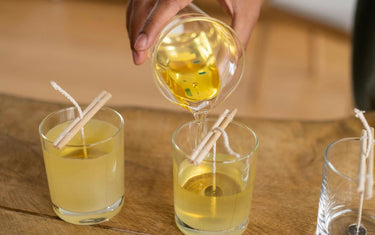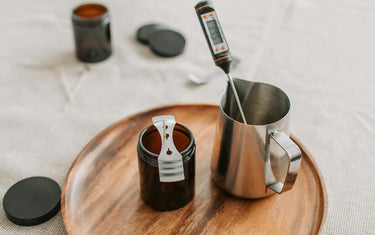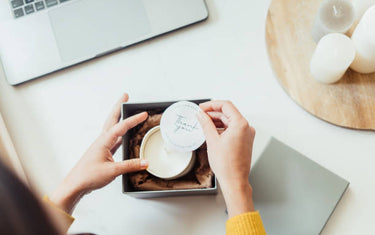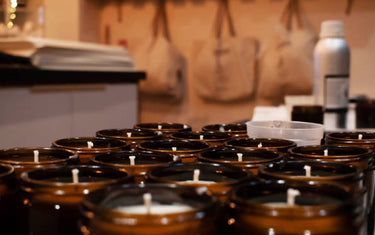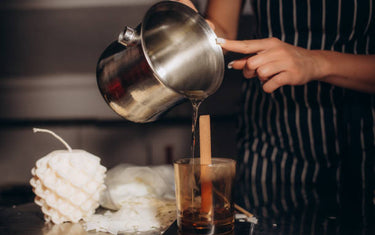5 min read / 12 August 2024 / yasmin sharp
1. Introduction to Candle Making
Discover the rich history of candle making from ancient times to modern uses, market trends, and innovations in sustainable and luxury candles.
Share this post
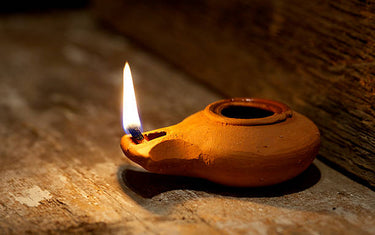
Throughout history, candles have undergone vast transformations. However, they have always remained a symbol of warmth and ambience, even to this day.
Below, we’ll examine the history of candle making, including its origins, significant developments, and current trends.

German beeswax candles dating from around the 6th or 7th century A.D.
Brief History of Candle Making
Ancient Beginnings
When you think of how candles were historically used, you may initially imagine candles propped on a castle wall.
However, the roots of their origins go much deeper than that. So, when were candles invented?
Egyptians (3000 BC): The history of candle-making actually starts with the Egyptians.
They would rely on torches made by dousing the pithy core of the reeds in melted animal fat, giving them a valuable light source to help them explore.
Romans (500 BC): Fast-forward a few millennia, and the Romans took the manufacture of candles to an entirely new level, creating the first candles with a wick.
This was a huge feat in the history of candles, making candles more reliable and usable. The Romans achieved this by repeatedly dipping rolled papyrus in melted tallow or beeswax, which helped create a longer burn with less smoke and soot.
China and Japan (200 BC): Meanwhile, across Asia, innovative candle making techniques were also evolving.
For example, in ancient China, candles were crafted out of whale fat, while in Japan, they utilised wax extracted from tree nuts.
India (400-500 AD): In India, the candle-making process involved boiling cinnamon to extract wax.
These early Indian candles not only provided light but also filled the air with the fragrant scent of cinnamon, making their candle-making methods particularly unique.

Handmade Chinese candles with a bamboo core.
Medieval Europe
Middle Ages (500-1500 AD): During the Middle Ages, candle making became a recognised craft in Europe.
It was during this period that beeswax candles were introduced. These candles were a game-changer—they burned cleaner and didn't produce the smoky flame typical of tallow candles.
However, their higher cost made them a luxury item, often reserved for churches and the wealthy.
Religious and Practical Use: Candles were often used in religious ceremonies, symbolising light in the darkness.
Some of their practical uses during this period were lighting homes, businesses, and streets before gas or electric lighting.
Renaissance to 19th Century
Colonial America: Candle making in colonial America all started with bayberries when early American settlers discovered that they could be boiled to produce a sweet-smelling wax.
However, it took many bayberries to make just one candle, so it was a rare occasion that these types of candles were made.
18th Century: The 18th century saw the introduction of spermaceti wax, which is made from sperm whale oil.
This wax quickly became notable for its hard texture and bright, odourless flame, and it had a significant impact on the history of candle making.
19th Century: Edging closer to the current day, the 19th century saw a massive leap in how candles were made. In the 1820s, stearin wax was developed from animal fats and was seen as very reliable.
However, the introduction of paraffin wax in the 1850s truly revolutionised the candle-making industry.
This particular wax, which you may have heard of already, is made from petroleum, coal, or oil shale. The best part? Paraffin wax was cheap and efficient, and helped make candles more accessible for everyone.

Modern Uses and Market Trends
Now that you understand the history of candle making a bit better, we can look at how the practice has evolved until the present day. Candle making today looks a lot different than it did in the past.
Modern Uses
Modern candles serve many purposes, and many people use them for reasons beyond just illuminating their space. Let’s take a look at some of the uses of candles below.
Decorative and Ambiance: Many people use candles to decorate their spaces and add a touch of warmth and ambience. They can also help people relax and unwind.
Aromatherapy: Scented candles have become a popular choice for aromatherapy. It’s easy to do from home, and the candles' scent can help promote relaxation and stress relief.
Religious and Ceremonial: Candles continue to play a significant role in religious rituals, ceremonies, and festivals across various cultures, symbolising hope, faith, and the presence of the divine.
Emergency Lighting: Candles are still a reliable light source during power outages and emergencies. Many people find it helpful to have them on hand in case of any power cuts.

Candle Market Trends
The candle industry is booming, and various exciting candle market trends are shaping the current market. Here are some candle trends we are currently seeing:
Growth in Demand: The global candle market has seen consistent growth thanks to increasing consumer interest in home decor products.
As people seek ways to improve their living spaces and make it smell nice, candles have become a go-to. Examples could include the rise of scented, decorative, and candles with unique shapes and designs.
Sustainability and Natural Products: Like many other markets, there is an ever-increasing trend towards eco-friendly and sustainable candles made from soy wax, beeswax, and other natural ingredients.
As consumers become more eco-conscious, demand is rising for sustainable options.
Customisation and Personalisation: We all like to add our own personal touch. The desire for personalised products has led to a rise in custom candle-making kits and DIY options, which is positive for the candle-making industry.
Luxury and High-End Candles: The market for luxury candles is thriving, with high-end brands offering premium products with unique scents and elegant designs. These candles often come in attractive packaging that doubles as decorative pieces that appeal to customers.
Innovative Products: The candle industry is not just sticking to tradition. Some innovations we have seen include candles with wooden wicks that crackle like a fireplace and candles with hidden jewellery. There are even candles that change colour as they burn.

Understanding the history of candle making from ancient times to the modern day can help you better grasp the market and how techniques have evolved over time. You may even find that it helps you tweak and improve your current candle-making practices.
If you’re looking at how to make candles or want to explore candle-making business opportunities, then we can help you. Sign up for our wholesale for exclusive discounts and access to high-quality fragrance oils you can use when making your candles.

